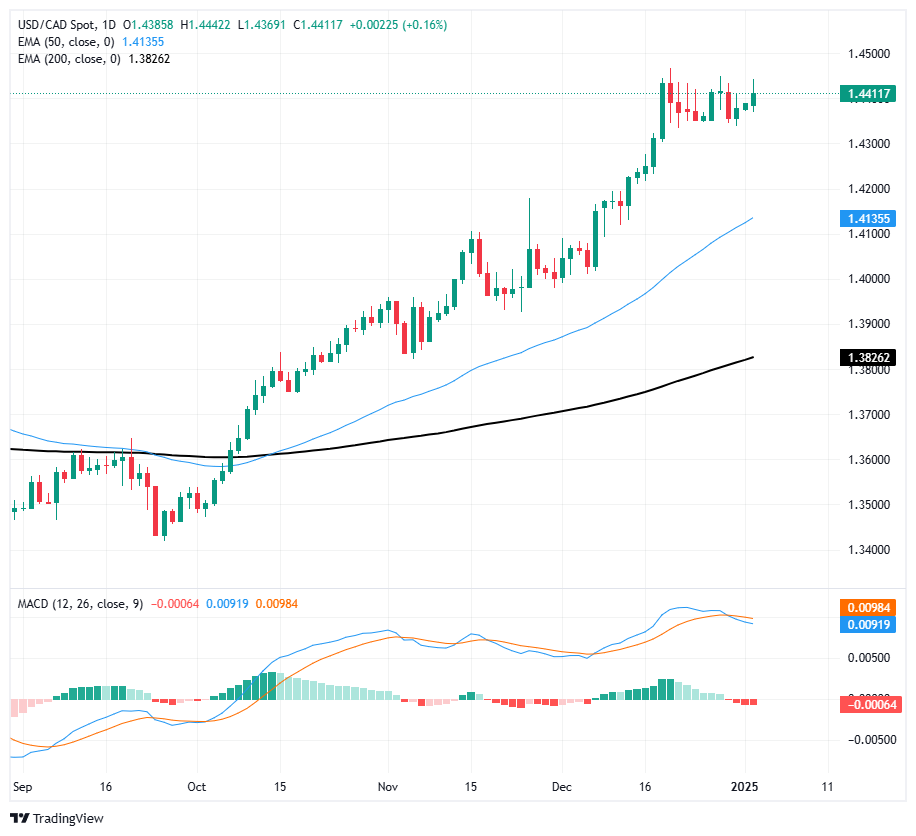- The Canadian Dollar (CAD) remained stagnant against the US Dollar on Thursday.
- Canadian PMI data for December beat expectations but failed to trigger a CAD recovery.
- Friday’s US PMI data will be the number to beat for increased risk appetite.
The Canadian Dollar (CAD) remained stagnant against the Dollar on Thursday, with CAD traders starting the new year with a lukewarm stance. After losing almost eight percent top to bottom during the last quarter of 2024, the CAD is struggling to find a technical recovery as market expectations weigh on the CAD.
December Canada Purchasing Managers’ Index (PMI) survey results beat expectations, rising when median market forecasts expected a decline, but the mid-level figure failed to trigger a recovery in the battered CAD. Markets are choppy as investors prepare for the 2025 trading season, and overall market volumes remain tight following the midweek New Year’s holiday on both sides of the 49th parallel.
Daily Market Summary: CAD remains on the downside as the new year begins
- Canada’s manufacturing PMI survey for December rose to 52.2, beating the forecast drop to 51.9 from 52.0 previously.
- Despite the positive data, the CAD remains undervalued near multi-year lows.
- Initial US jobless claims cooled to 221,000 for the week ending December 27, undermining the forecast increase to 222,000 from 220,000 the previous week, helping to support the US dollar.
- Canada data is finalized for the week.
- US ISM PMI figures will be released on Friday to close the trading week, and are expected to be flat in December at a contractionary 48.4.
Canadian Dollar Price Forecast: CAD Awaits Technical Correction
The Canadian Dollar remains in a firmly bearish technical stance heading into 2025, with the CAD stuck near multi-year lows against the US Dollar. The USD/CAD chart continues to make chart gains near 1.4400, keeping the price action stuck near the pair’s highest non-pandemic prices since 2016.
The one-sided bearish action in the CAD has kept the USD/CAD strengthened at highs along with a general recovery in the Dollar, and the CAD bidders are struggling to find their footing. However, failure to continue rising from here could give CAD bulls a new spark to reverse the bids and force USD/CAD back towards the 50-day EMA near 1.4135.
USD/CAD daily chart
Canadian Dollar FAQs
The key factors that determine the price of the Canadian Dollar (CAD) are the level of interest rates set by the Bank of Canada (BoC), the price of oil, Canada’s main export product, the health of its economy, inflation and the trade balance, which is the difference between the value of Canadian exports and its imports. Other factors are market confidence, that is, whether investors bet on riskier assets (risk-on) or look for safe assets (risk-off), with the risk-on being positive for the CAD. As its largest trading partner, the health of the US economy is also a key factor influencing the Canadian dollar.
The Bank of Canada (BoC) exerts significant influence over the Canadian Dollar by setting the level of interest rates that banks can lend to each other. This influences the level of interest rates for everyone. The BoC’s main objective is to keep inflation between 1% and 3% by adjusting interest rates up or down. Relatively high interest rates are usually positive for the CAD. The Bank of Canada can also use quantitative easing and tightening to influence credit conditions, with the former being negative for the CAD and the latter being positive for the CAD.
The price of oil is a key factor influencing the value of the Canadian Dollar. Oil is Canada’s largest export, so the price of oil tends to have an immediate impact on the value of the CAD. Generally, if the price of oil rises, the CAD also rises, as aggregate demand for the currency increases. The opposite occurs if the price of oil falls. Higher oil prices also tend to lead to a higher probability of a positive trade balance, which also supports the CAD.
Although inflation has traditionally always been considered a negative factor for a currency, as it reduces the value of money, the opposite has actually happened in modern times, with the relaxation of cross-border capital controls. Higher inflation often leads central banks to raise interest rates, attracting more capital inflows from global investors looking for a lucrative place to store their money. This increases the demand for the local currency, which in the case of Canada is the Canadian Dollar.
The published macroeconomic data measures the health of the economy and may have an impact on the Canadian dollar. Indicators such as GDP, manufacturing and services PMIs, employment and consumer confidence surveys can influence the direction of the CAD. A strong economy is good for the Canadian dollar. Not only does it attract more foreign investment, but it may encourage the Bank of Canada to raise interest rates, resulting in a stronger currency. However, if economic data is weak, the CAD is likely to fall.
Source: Fx Street
I am Joshua Winder, a senior-level journalist and editor at World Stock Market. I specialize in covering news related to the stock market and economic trends. With more than 8 years of experience in this field, I have become an expert in financial reporting.







